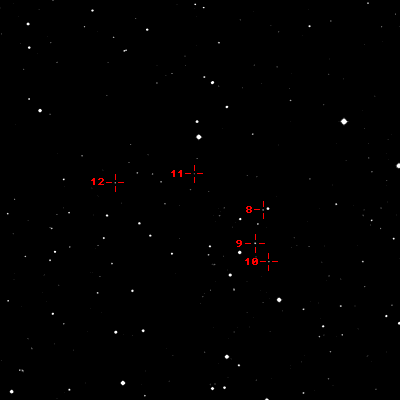
Five closely associated quasars in Cetus, which could easily fit within the frame of a CCD with a field of view greater than 10 arcminutes. This quasar cluster would be the ideal set to monitor for proper motion because the density is particularly high; a factor greater than 60 over the average quasar density (Arp et al., 1983). Coordinates of QSO 8, 9, 10, 11 and 12 are in table below.
QSO Other RA (2000) DEC (2000) V (B-V) (U-B) Z(EM)
names
0107-025 QSO 10 1 10 13.19 -2 19 52.9 18.2 0.956
0107-025 QSO 8 1 10 14.59 -2 16 58.0 18.4 0.726
0107-025 QSO 9 1 10 16.29 -2 18 51.2 17.4 0.952
0107-025 QSO 11 1 10 30.19 -2 14 55.0 1.891
0107-025 QSO 12 1 10 48.05 -2 15 25.4 1.24
(Note QSO 10=PB 8553, QSO 9=PB 6291)
1258+287 PB 3207 13 0 28.73 28 30 8.5 17.38 .30 -.80 0.648
1258+286 PB 3214 13 0 48.23 28 23 19.8 17.75* .07 -1.12 1.922
1258+285 PB 3216 13 1 1.52 28 19 48.1 17.4 * .30 1.355
1623+271 KP 72 16 25 11.14 27 3 12.2 18.0 1.44
1623+269 4C 26.48 16 25 14.32 26 50 26.7 17.5 * 0.779
1623+268 KP 76 16 25 47.71 26 44 42.6 18 2.467
1623+268 KP 77 16 25 48.26 26 47 9.7 17.3 2.526
1241+176 12 44 10.85 17 21 4.6 15.38 1.273
1242+178 12 44 58.85 17 32 58.1 17.9 0.265
1242+176 12 45 26.82 17 20 51.8 18.0 1.857
1228+078 KP 16 12 30 34.24 7 33 5.4 17.47 -.06 -.99 1.816
1228+076 KP 17 12 31 7.92 7 24 38.5 17.5 1.878
1228+077 KP 18 12 31 20.51 7 25 57.6 17.59 -.01 -.07 2.391
0056-001 PHL 923 0 59 5.49 0 6 51.2 17.02 .20 -.70 0.717
0056+001 0 59 18.25 0 25 19.1 18.0 0.613
0057+000 1 0 2.31 0 16 42.3 17.2 0.776
1429-006 14 31 43.69 -0 50 11.5 17.8 1.179
1429-008 14 32 29.12 -1 6 15.9 17.74 2.078
1429-006 14 32 31.05 -0 52 28.9 18.2 0.361
1430-007 14 32 44.33 -0 59 15.1 17.8 1.022
1430-006 14 33 21.33 -0 54 45.5 16.4 1.116
0048-015 0 50 51.51 -1 17 37.3 17.2 0.763
0048-013 PHL 857 0 51 2.47 -1 2 43.4 17.9 1.87
0049-013 0 51 35.25 -1 7 10.0 17.8 1.560
0037-018 UM 264 0 40 18.22 -1 37 22.4 18 2.34
0037-019 0 40 18.31 -1 40 59.6 17.73 0.296
0038-019 UM 266 0 41 26.01 -1 43 16.0 16.86 1.674
0050-253 MD1:85 0 52 44.67 -25 6 51.6 15.9 .20 2.18
0050-254 0 53 8.07 -25 11 22.4 17.6 1.019
0051-253 0 53 53.61 -25 4 6.1 17.5 1.444
0100-423 B16.09 1 3 4.90 -42 3 57.1 17.7 2.33
0100-423 MD6:138 1 3 5.03 -42 4 3.6 18.0 1.88
0101-422 1 3 18.97 -42 0 48.3 17.5 1.90
2134-426 21 37 47.89 -42 26 11.6 17.9 1.804
2135-427 21 38 24.04 -42 30 16.1 17.2 0.250
2135-428 21 38 30.12 -42 39 56.8 17.91* -.78 1.46
0315-553 MZZ 4875 3 16 50.25 -55 11 9.9 17.91 2.531
0316-555 MZZ 8525 3 17 32.73 -55 20 25.3 17.97 0.406
0316-555 MZZ 6346 3 18 18.74 -55 20 1.8 17.56 0.871